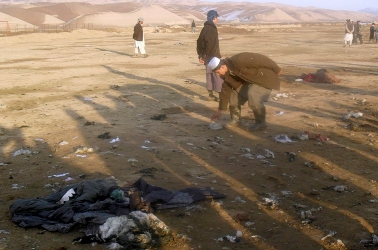
The suicide bombing that hit a densely packed funeral procession in Sare-i Sang village, Taloqan District, Takhar province today killed over 19 people and injured well over 50 civilians, according to Afghan authorities. Among those killed was a provincial strongman turned Member of Parliament (Wolesi Jirga), Alhaj Mutalib Baig, an Uzbek commander who previously served as the chief of police for Takhar (2004) and Kunduz (2006) provinces. Afghan officials believe the bomber specifically targeted Baig, killing him as he prayed among throngs of civilians attending a funeral ceremony.
Baig’s murder is the latest in a series of assassinations of high-profile anti-Taliban mujahideen leaders from northern Afghanistan, and mimics similar tactics used in other such assassinations; namely that the attack took place in public, the heavy presence of civilians did not deter the bomber, and the attack occurred at approximately midday. Prior to Baig’s death:
- A suicide-bomber killed the head of Jamiat-e-Islami, Burhanuddin Rabbani on Sept. 20, 2011.
- A Taliban hit team stormed the provincial compound of Abdul Baseer Salangi with suicide bombers and “commandos,” resulting in 22 killed, on Aug. 14, 2011. Governor Salangi escaped the attack unharmed.
- A Taliban suicide bomber attempted to assassinate Abdul Baseer Salangi, the current governor of Parwan province and former commander of the anti-Taliban movement known as the United Islamic Front for the Salvation of Afghanistan, on June, 21 2011.
- A strategically placed remote-controlled bomb killed the top anti-Taliban police commander, General Daud Daud, and Daud’s former Shura-e-Nazar deputy, Shah Jahan Noori, on May, 28 2011.
- A suicide bomber attacked General Abdul Rahman Sayedkhili, the provincial chief of police, in a bazaar in Kunduz City, and killed him along with four of his bodyguards on March 10, 2011.
- A Taliban suicide bomber killed Mohammad Omar, the provincial governor of Kunduz province, along with 14 other people, as he and a congregation prayed at a mosque in the neighboring province of Tahkar on Oct. 8, 2010.
Although Baig was an ethnic Uzbek, he did not endorse the Jombesh-e-milli party of Uzbek commander General Rashid Dostum until after 2001.* Instead he fought for the Tajik-led Jamiat-e-Islami during the Soviet-Afghan war and later fought against the Taliban on the Kunduz and Takhar front. By 2002, Baig maintained links with Jombesh commanders in both Kunduz and Takhar, facilitating the movement of anti-Taliban Uzbek fighters to Kunduz during his tenure as police chief in 2006, and later distributed weapons to anti-Taliban fighters along with Piram Qul (member of Wolesi Jirga), Qazi Kabir (member of Mershano Jirga), Mohammad Bashir Qant Chah Aabi (former Governor of Sar-i-Pul and Jamiat-e-Islami commander), and Mamoor Hassan, the Jombesh commander for Takhar’s Dasht -i-Qala district. In 2010, Baig left his post as deputy minister of borders and tribal affairs and ran for the Wolesi Jirga (Lower House of Parliament), which he won with over 4,000 votes. Although Baig belonged to the Saadat parliamentary bloc, he ran as an independent in 2010.
Among locals, Baig had been routinely accused of illegal land grabs in Taloqan, the provincial capital of Takhar province, and he had also been fingered for involvement in the region’s lucrative drug-trafficking business. The death of Baig bears the strategic hallmarks of the recent assassination campaign against former mujahideen commanders in northern Afghanistan, a campaign associated mostly with the Taliban’s northern military network (and its leadership in Pakistan) and facilitated by members of the Islamic Movement of Uzbekistan (IMU).
Shortly after the death of General Daud Daud, ISAF released a statement indicating that a combined Afghan and Coalition operation in Balkh province had arrested several individuals linked to the May 28 bomb attack that killed General Daud and Shah Jahan Noori. Among those captured was a suspected Islamic Movement of Uzbekistan (IMU) commander. The IMU is deeply ingrained in the insurgent infrastructure throughout northern Afghanistan, and IMU members are known to hold several shadow government positions for the Taliban’s northern military zone. These include positions in Takhar, Kunduz, Badakhshan, Balkh, Jawzjan, and Sar-i-Pul provinces.
No group has yet claimed responsibility for today’s suicide attack in Takhar, although senior Afghan and US officials and have blamed the Taliban. Many, like Haji Fareed Zaki, the deputy governor of Takhar province, doubt that the Taliban movement will claim responsibility, since so many civilians were killed or wounded in the attack.
* Baig participated in the Second Congress of Jombesh in June 2002, which ultimately paved the way for Uzbek militia commanders in Takhar to unite under the Jombesh party in 2003.







